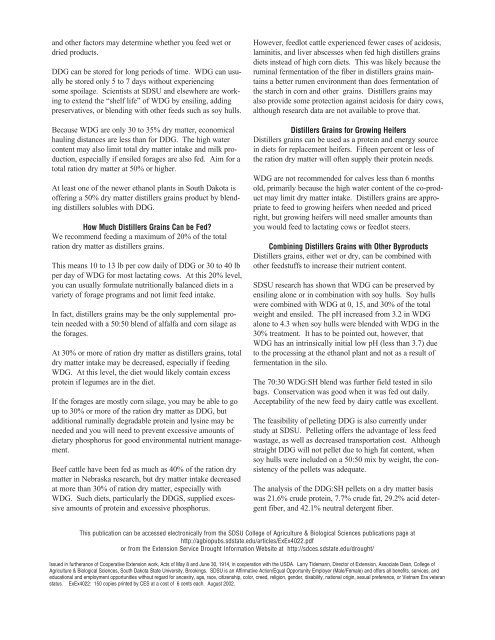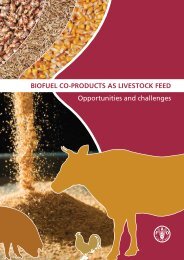Distillers Grains Feeding Recommendations. - Distillers Grains By ...
Distillers Grains Feeding Recommendations. - Distillers Grains By ...
Distillers Grains Feeding Recommendations. - Distillers Grains By ...
Create successful ePaper yourself
Turn your PDF publications into a flip-book with our unique Google optimized e-Paper software.
and other factors may determine whether you feed wet ordried products.DDG can be stored for long periods of time. WDG can usuallybe stored only 5 to 7 days without experiencingsome spoilage. Scientists at SDSU and elsewhere are workingto extend the “shelf life” of WDG by ensiling, addingpreservatives, or blending with other feeds such as soy hulls.Because WDG are only 30 to 35% dry matter, economicalhauling distances are less than for DDG. The high watercontent may also limit total dry matter intake and milk production,especially if ensiled forages are also fed. Aim for atotal ration dry matter at 50% or higher.At least one of the newer ethanol plants in South Dakota isoffering a 50% dry matter distillers grains product by blendingdistillers solubles with DDG.How Much <strong>Distillers</strong> <strong>Grains</strong> Can be Fed?We recommend feeding a maximum of 20% of the totalration dry matter as distillers grains.This means 10 to 13 lb per cow daily of DDG or 30 to 40 lbper day of WDG for most lactating cows. At this 20% level,you can usually formulate nutritionally balanced diets in avariety of forage programs and not limit feed intake.In fact, distillers grains may be the only supplemental proteinneeded with a 50:50 blend of alfalfa and corn silage asthe forages.At 30% or more of ration dry matter as distillers grains, totaldry matter intake may be decreased, especially if feedingWDG. At this level, the diet would likely contain excessprotein if legumes are in the diet.If the forages are mostly corn silage, you may be able to goup to 30% or more of the ration dry matter as DDG, butadditional ruminally degradable protein and lysine may beneeded and you will need to prevent excessive amounts ofdietary phosphorus for good environmental nutrient management.Beef cattle have been fed as much as 40% of the ration drymatter in Nebraska research, but dry matter intake decreasedat more than 30% of ration dry matter, especially withWDG. Such diets, particularly the DDGS, supplied excessiveamounts of protein and excessive phosphorus.However, feedlot cattle experienced fewer cases of acidosis,laminitis, and liver abscesses when fed high distillers grainsdiets instead of high corn diets. This was likely because theruminal fermentation of the fiber in distillers grains maintainsa better rumen environment than does fermentation ofthe starch in corn and other grains. <strong>Distillers</strong> grains mayalso provide some protection against acidosis for dairy cows,although research data are not available to prove that.<strong>Distillers</strong> <strong>Grains</strong> for Growing Heifers<strong>Distillers</strong> grains can be used as a protein and energy sourcein diets for replacement heifers. Fifteen percent or less ofthe ration dry matter will often supply their protein needs.WDG are not recommended for calves less than 6 monthsold, primarily because the high water content of the co-productmay limit dry matter intake. <strong>Distillers</strong> grains are appropriateto feed to growing heifers when needed and pricedright, but growing heifers will need smaller amounts thanyou would feed to lactating cows or feedlot steers.Combining <strong>Distillers</strong> <strong>Grains</strong> with Other <strong>By</strong>products<strong>Distillers</strong> grains, either wet or dry, can be combined withother feedstuffs to increase their nutrient content.SDSU research has shown that WDG can be preserved byensiling alone or in combination with soy hulls. Soy hullswere combined with WDG at 0, 15, and 30% of the totalweight and ensiled. The pH increased from 3.2 in WDGalone to 4.3 when soy hulls were blended with WDG in the30% treatment. It has to be pointed out, however, thatWDG has an intrinsically initial low pH (less than 3.7) dueto the processing at the ethanol plant and not as a result offermentation in the silo.The 70:30 WDG:SH blend was further field tested in silobags. Conservation was good when it was fed out daily.Acceptability of the new feed by dairy cattle was excellent.The feasibility of pelleting DDG is also currently understudy at SDSU. Pelleting offers the advantage of less feedwastage, as well as decreased transportation cost. Althoughstraight DDG will not pellet due to high fat content, whensoy hulls were included on a 50:50 mix by weight, the consistencyof the pellets was adequate.The analysis of the DDG:SH pellets on a dry matter basiswas 21.6% crude protein, 7.7% crude fat, 29.2% acid detergentfiber, and 42.1% neutral detergent fiber.This publication can be accessed electronically from the SDSU College of Agriculture & Biological Sciences publications page athttp://agbiopubs.sdstate.edu/articles/ExEx4022.pdfor from the Extension Service Drought Information Website at http://sdces.sdstate.edu/drought/Issued in furtherance of Cooperative Extension work, Acts of May 8 and June 30, 1914, in cooperation with the USDA. Larry Tidemann, Director of Extension, Associate Dean, College ofAgriculture & Biological Sciences, South Dakota State University, Brookings. SDSU is an Affirmative Action/Equal Opportunity Employer (Male/Female) and offers all benefits, services, andeducational and employment opportunities without regard for ancestry, age, race, citizenship, color, creed, religion, gender, disability, national origin, sexual preference, or Vietnam Era veteranstatus. ExEx4022: 150 copies printed by CES at a cost of 6 cents each. August 2002.
















